Effective HR Management and Strategic Planning
VerifiedAdded on 2021/04/17
|13
|2989
|27
AI Summary
The provided document discusses the importance of effective human resource management in organizations. It highlights the need for training and development programs to enhance knowledge gaps and team work among senior managers and employees. The document also emphasizes the significance of evaluation, feedback, and surveys to assess the effectiveness of HRM policies and practices. Additionally, it touches on international human resource management practices and provides a comprehensive overview of HRM strategies for multinational enterprises.
Contribute Materials
Your contribution can guide someone’s learning journey. Share your
documents today.
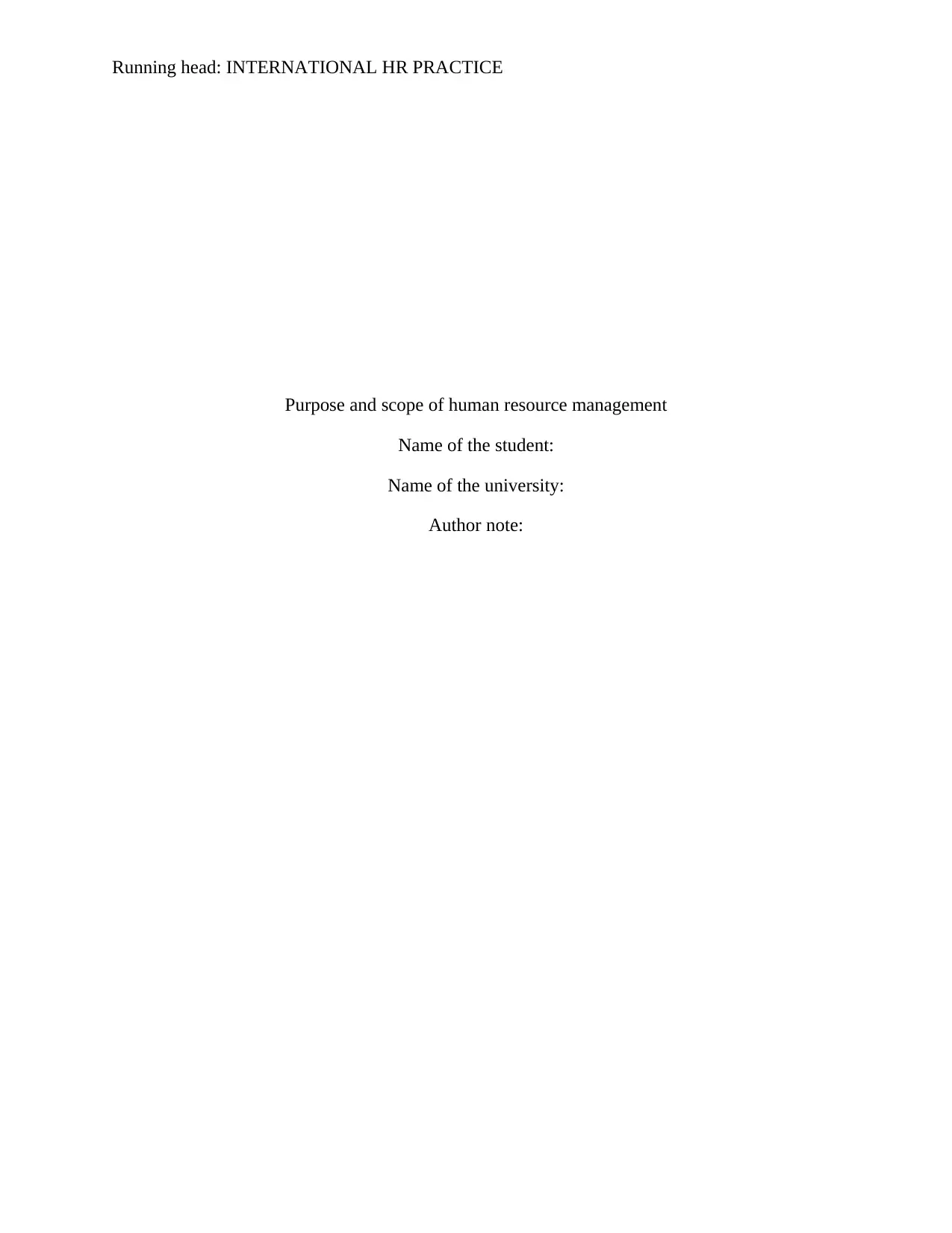
Running head: INTERNATIONAL HR PRACTICE
Purpose and scope of human resource management
Name of the student:
Name of the university:
Author note:
Purpose and scope of human resource management
Name of the student:
Name of the university:
Author note:
Secure Best Marks with AI Grader
Need help grading? Try our AI Grader for instant feedback on your assignments.
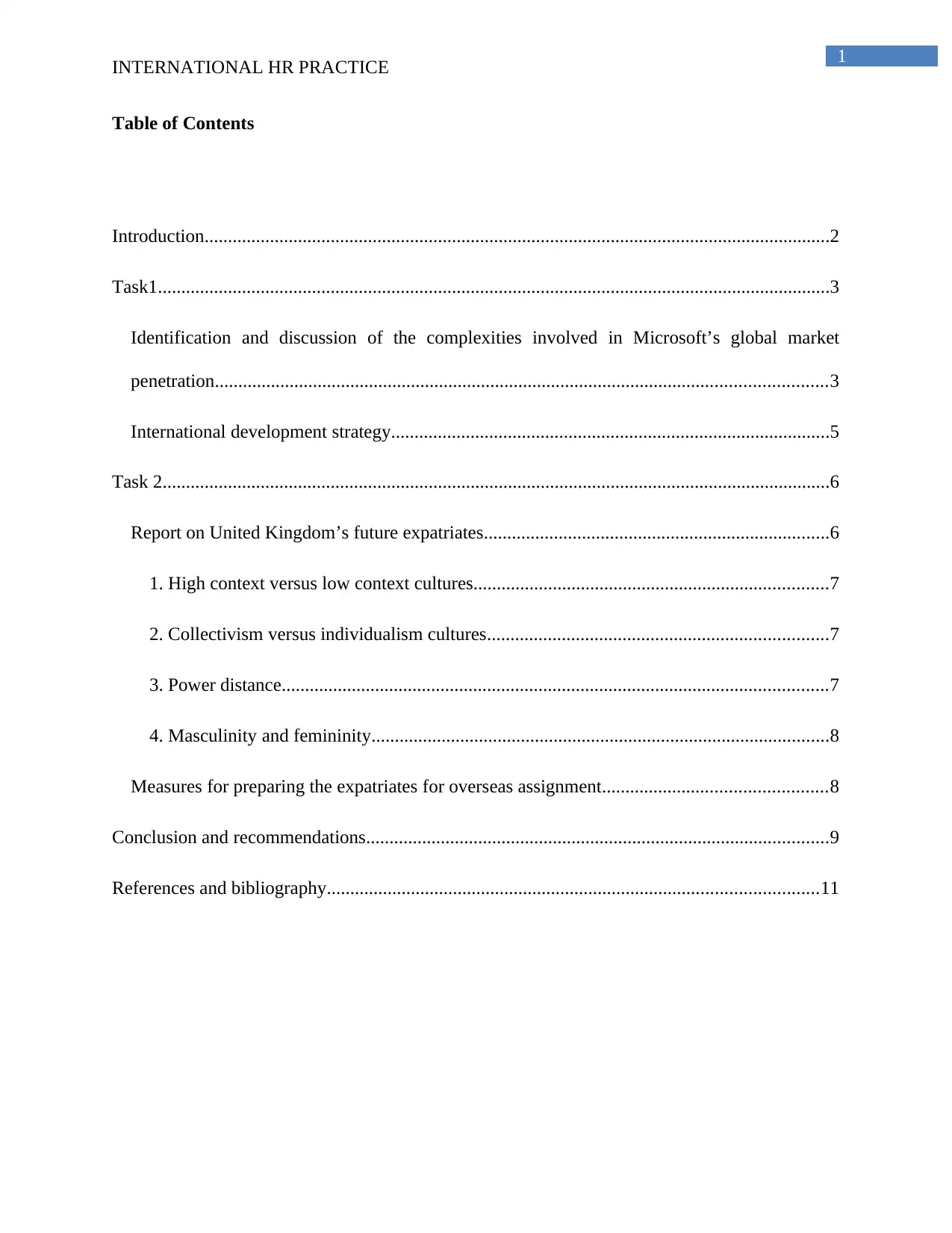
1
INTERNATIONAL HR PRACTICE
Table of Contents
Introduction......................................................................................................................................2
Task1................................................................................................................................................3
Identification and discussion of the complexities involved in Microsoft’s global market
penetration...................................................................................................................................3
International development strategy..............................................................................................5
Task 2...............................................................................................................................................6
Report on United Kingdom’s future expatriates..........................................................................6
1. High context versus low context cultures............................................................................7
2. Collectivism versus individualism cultures.........................................................................7
3. Power distance.....................................................................................................................7
4. Masculinity and femininity..................................................................................................8
Measures for preparing the expatriates for overseas assignment................................................8
Conclusion and recommendations...................................................................................................9
References and bibliography.........................................................................................................11
INTERNATIONAL HR PRACTICE
Table of Contents
Introduction......................................................................................................................................2
Task1................................................................................................................................................3
Identification and discussion of the complexities involved in Microsoft’s global market
penetration...................................................................................................................................3
International development strategy..............................................................................................5
Task 2...............................................................................................................................................6
Report on United Kingdom’s future expatriates..........................................................................6
1. High context versus low context cultures............................................................................7
2. Collectivism versus individualism cultures.........................................................................7
3. Power distance.....................................................................................................................7
4. Masculinity and femininity..................................................................................................8
Measures for preparing the expatriates for overseas assignment................................................8
Conclusion and recommendations...................................................................................................9
References and bibliography.........................................................................................................11
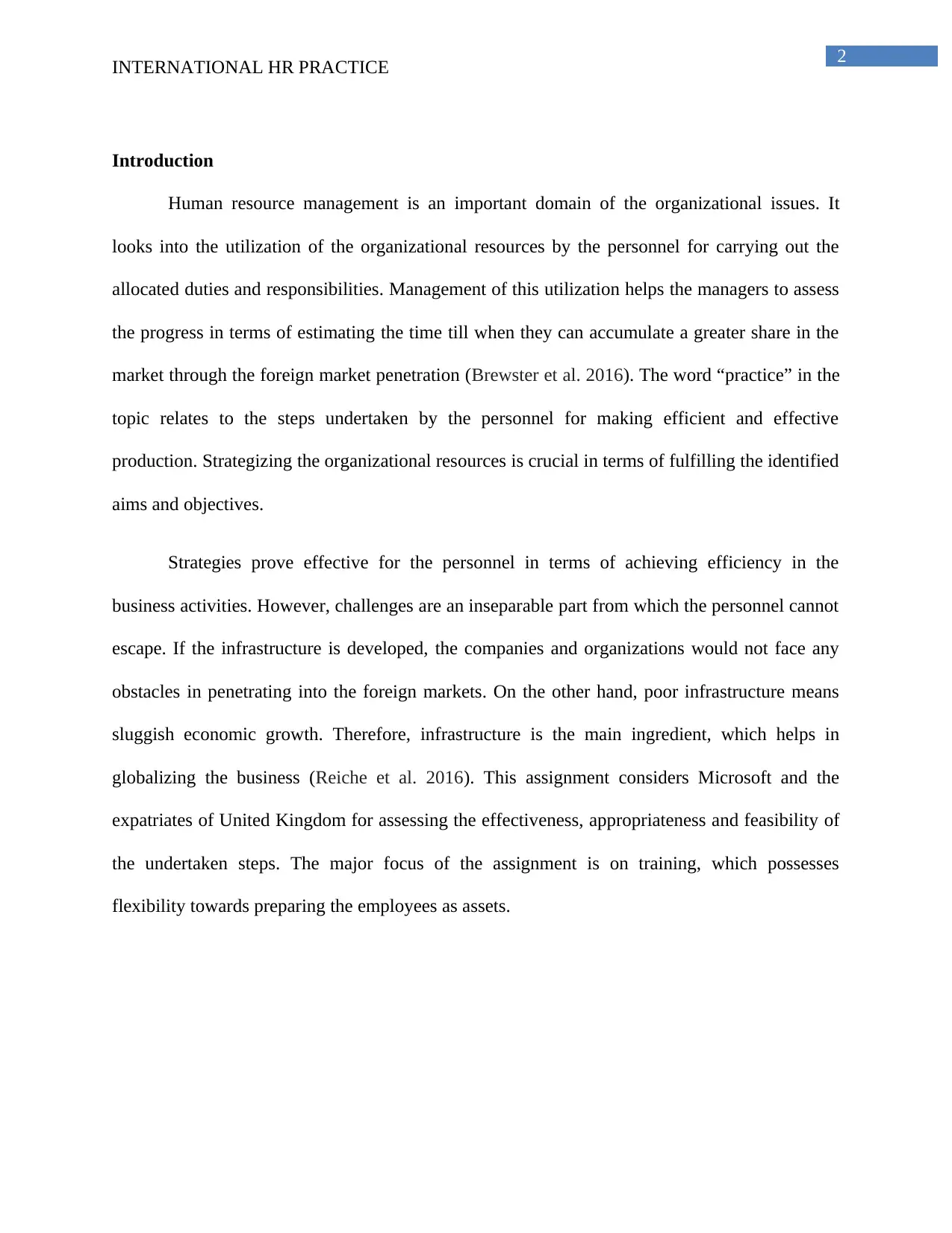
2
INTERNATIONAL HR PRACTICE
Introduction
Human resource management is an important domain of the organizational issues. It
looks into the utilization of the organizational resources by the personnel for carrying out the
allocated duties and responsibilities. Management of this utilization helps the managers to assess
the progress in terms of estimating the time till when they can accumulate a greater share in the
market through the foreign market penetration (Brewster et al. 2016). The word “practice” in the
topic relates to the steps undertaken by the personnel for making efficient and effective
production. Strategizing the organizational resources is crucial in terms of fulfilling the identified
aims and objectives.
Strategies prove effective for the personnel in terms of achieving efficiency in the
business activities. However, challenges are an inseparable part from which the personnel cannot
escape. If the infrastructure is developed, the companies and organizations would not face any
obstacles in penetrating into the foreign markets. On the other hand, poor infrastructure means
sluggish economic growth. Therefore, infrastructure is the main ingredient, which helps in
globalizing the business (Reiche et al. 2016). This assignment considers Microsoft and the
expatriates of United Kingdom for assessing the effectiveness, appropriateness and feasibility of
the undertaken steps. The major focus of the assignment is on training, which possesses
flexibility towards preparing the employees as assets.
INTERNATIONAL HR PRACTICE
Introduction
Human resource management is an important domain of the organizational issues. It
looks into the utilization of the organizational resources by the personnel for carrying out the
allocated duties and responsibilities. Management of this utilization helps the managers to assess
the progress in terms of estimating the time till when they can accumulate a greater share in the
market through the foreign market penetration (Brewster et al. 2016). The word “practice” in the
topic relates to the steps undertaken by the personnel for making efficient and effective
production. Strategizing the organizational resources is crucial in terms of fulfilling the identified
aims and objectives.
Strategies prove effective for the personnel in terms of achieving efficiency in the
business activities. However, challenges are an inseparable part from which the personnel cannot
escape. If the infrastructure is developed, the companies and organizations would not face any
obstacles in penetrating into the foreign markets. On the other hand, poor infrastructure means
sluggish economic growth. Therefore, infrastructure is the main ingredient, which helps in
globalizing the business (Reiche et al. 2016). This assignment considers Microsoft and the
expatriates of United Kingdom for assessing the effectiveness, appropriateness and feasibility of
the undertaken steps. The major focus of the assignment is on training, which possesses
flexibility towards preparing the employees as assets.
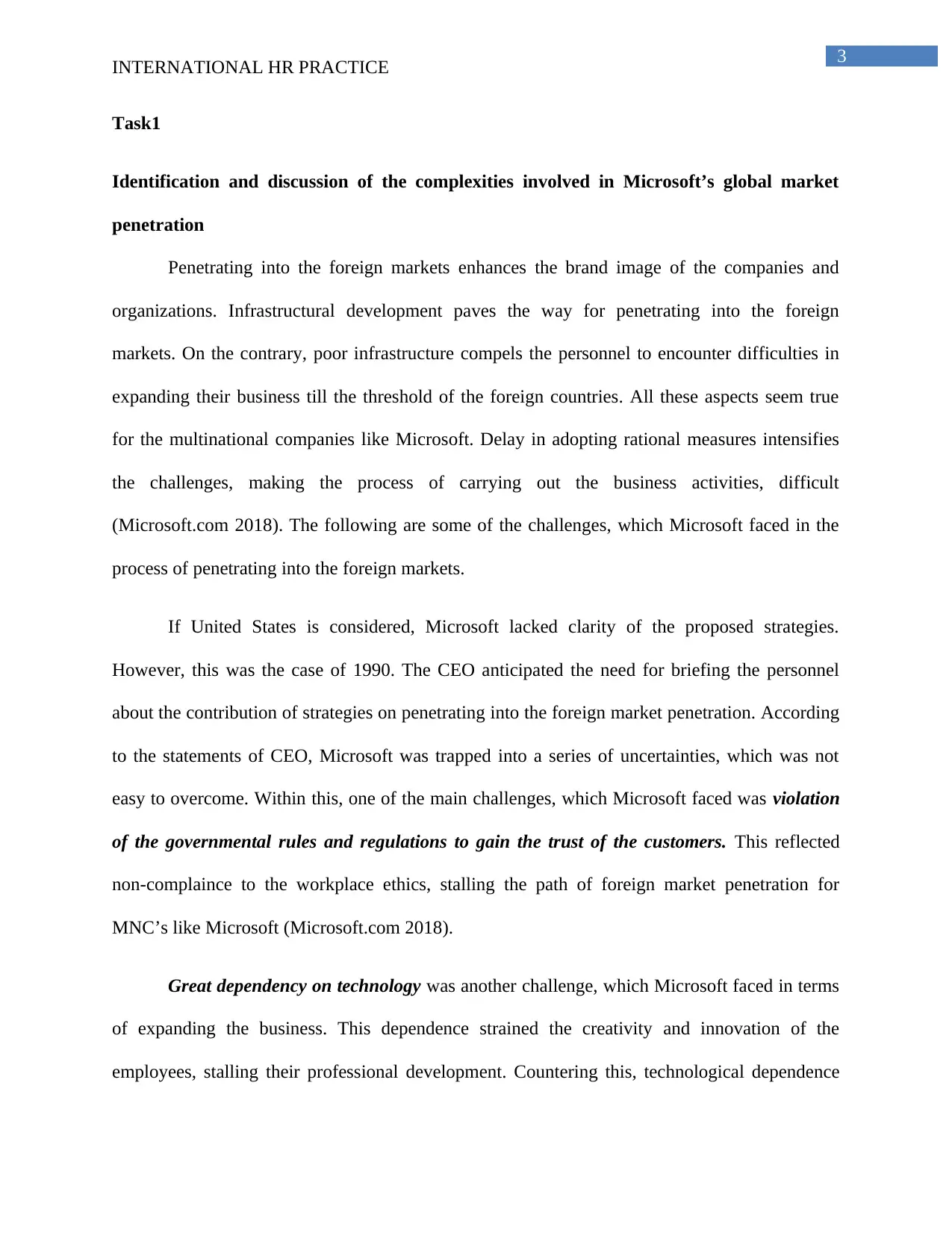
3
INTERNATIONAL HR PRACTICE
Task1
Identification and discussion of the complexities involved in Microsoft’s global market
penetration
Penetrating into the foreign markets enhances the brand image of the companies and
organizations. Infrastructural development paves the way for penetrating into the foreign
markets. On the contrary, poor infrastructure compels the personnel to encounter difficulties in
expanding their business till the threshold of the foreign countries. All these aspects seem true
for the multinational companies like Microsoft. Delay in adopting rational measures intensifies
the challenges, making the process of carrying out the business activities, difficult
(Microsoft.com 2018). The following are some of the challenges, which Microsoft faced in the
process of penetrating into the foreign markets.
If United States is considered, Microsoft lacked clarity of the proposed strategies.
However, this was the case of 1990. The CEO anticipated the need for briefing the personnel
about the contribution of strategies on penetrating into the foreign market penetration. According
to the statements of CEO, Microsoft was trapped into a series of uncertainties, which was not
easy to overcome. Within this, one of the main challenges, which Microsoft faced was violation
of the governmental rules and regulations to gain the trust of the customers. This reflected
non-complaince to the workplace ethics, stalling the path of foreign market penetration for
MNC’s like Microsoft (Microsoft.com 2018).
Great dependency on technology was another challenge, which Microsoft faced in terms
of expanding the business. This dependence strained the creativity and innovation of the
employees, stalling their professional development. Countering this, technological dependence
INTERNATIONAL HR PRACTICE
Task1
Identification and discussion of the complexities involved in Microsoft’s global market
penetration
Penetrating into the foreign markets enhances the brand image of the companies and
organizations. Infrastructural development paves the way for penetrating into the foreign
markets. On the contrary, poor infrastructure compels the personnel to encounter difficulties in
expanding their business till the threshold of the foreign countries. All these aspects seem true
for the multinational companies like Microsoft. Delay in adopting rational measures intensifies
the challenges, making the process of carrying out the business activities, difficult
(Microsoft.com 2018). The following are some of the challenges, which Microsoft faced in the
process of penetrating into the foreign markets.
If United States is considered, Microsoft lacked clarity of the proposed strategies.
However, this was the case of 1990. The CEO anticipated the need for briefing the personnel
about the contribution of strategies on penetrating into the foreign market penetration. According
to the statements of CEO, Microsoft was trapped into a series of uncertainties, which was not
easy to overcome. Within this, one of the main challenges, which Microsoft faced was violation
of the governmental rules and regulations to gain the trust of the customers. This reflected
non-complaince to the workplace ethics, stalling the path of foreign market penetration for
MNC’s like Microsoft (Microsoft.com 2018).
Great dependency on technology was another challenge, which Microsoft faced in terms
of expanding the business. This dependence strained the creativity and innovation of the
employees, stalling their professional development. Countering this, technological dependence
Secure Best Marks with AI Grader
Need help grading? Try our AI Grader for instant feedback on your assignments.
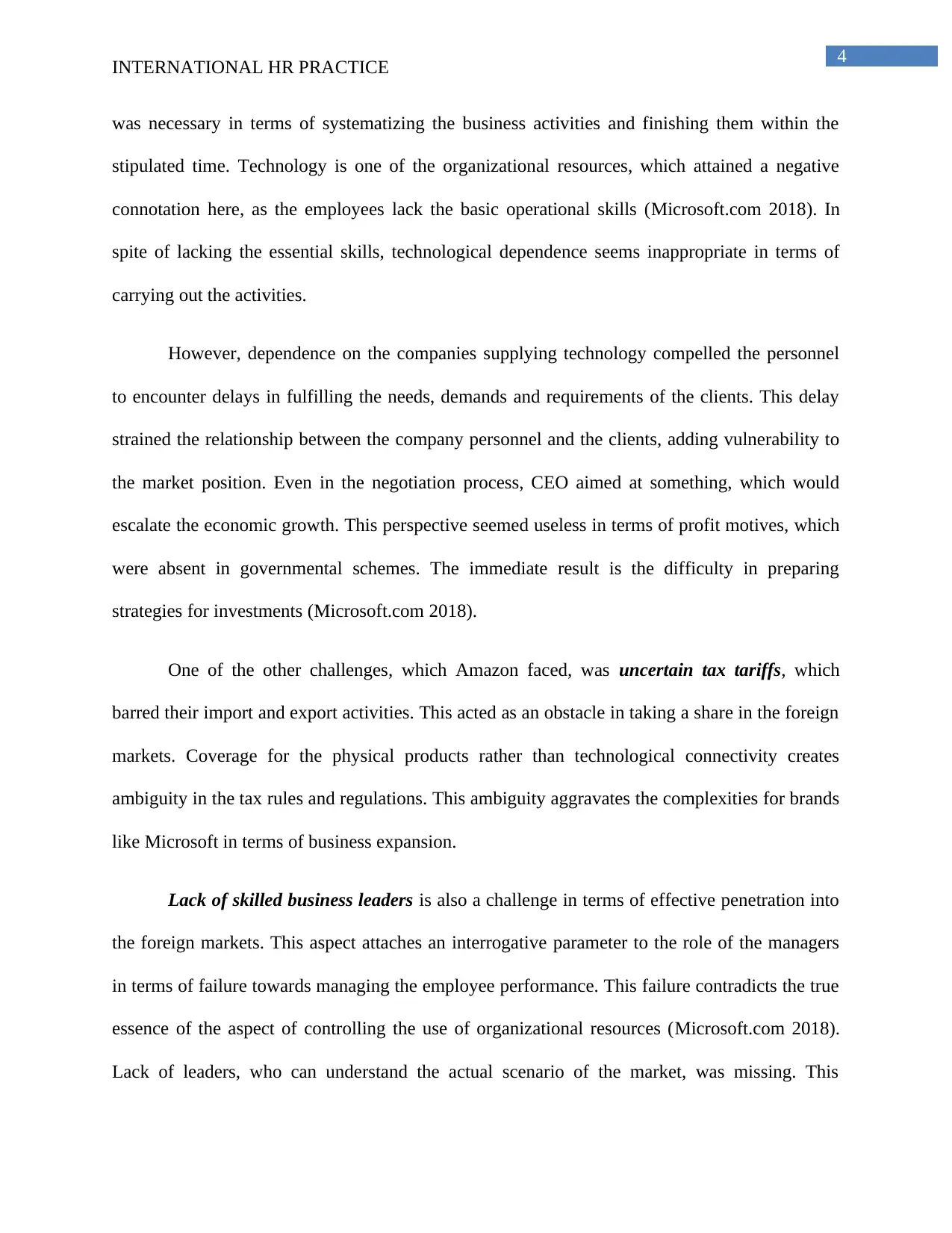
4
INTERNATIONAL HR PRACTICE
was necessary in terms of systematizing the business activities and finishing them within the
stipulated time. Technology is one of the organizational resources, which attained a negative
connotation here, as the employees lack the basic operational skills (Microsoft.com 2018). In
spite of lacking the essential skills, technological dependence seems inappropriate in terms of
carrying out the activities.
However, dependence on the companies supplying technology compelled the personnel
to encounter delays in fulfilling the needs, demands and requirements of the clients. This delay
strained the relationship between the company personnel and the clients, adding vulnerability to
the market position. Even in the negotiation process, CEO aimed at something, which would
escalate the economic growth. This perspective seemed useless in terms of profit motives, which
were absent in governmental schemes. The immediate result is the difficulty in preparing
strategies for investments (Microsoft.com 2018).
One of the other challenges, which Amazon faced, was uncertain tax tariffs, which
barred their import and export activities. This acted as an obstacle in taking a share in the foreign
markets. Coverage for the physical products rather than technological connectivity creates
ambiguity in the tax rules and regulations. This ambiguity aggravates the complexities for brands
like Microsoft in terms of business expansion.
Lack of skilled business leaders is also a challenge in terms of effective penetration into
the foreign markets. This aspect attaches an interrogative parameter to the role of the managers
in terms of failure towards managing the employee performance. This failure contradicts the true
essence of the aspect of controlling the use of organizational resources (Microsoft.com 2018).
Lack of leaders, who can understand the actual scenario of the market, was missing. This
INTERNATIONAL HR PRACTICE
was necessary in terms of systematizing the business activities and finishing them within the
stipulated time. Technology is one of the organizational resources, which attained a negative
connotation here, as the employees lack the basic operational skills (Microsoft.com 2018). In
spite of lacking the essential skills, technological dependence seems inappropriate in terms of
carrying out the activities.
However, dependence on the companies supplying technology compelled the personnel
to encounter delays in fulfilling the needs, demands and requirements of the clients. This delay
strained the relationship between the company personnel and the clients, adding vulnerability to
the market position. Even in the negotiation process, CEO aimed at something, which would
escalate the economic growth. This perspective seemed useless in terms of profit motives, which
were absent in governmental schemes. The immediate result is the difficulty in preparing
strategies for investments (Microsoft.com 2018).
One of the other challenges, which Amazon faced, was uncertain tax tariffs, which
barred their import and export activities. This acted as an obstacle in taking a share in the foreign
markets. Coverage for the physical products rather than technological connectivity creates
ambiguity in the tax rules and regulations. This ambiguity aggravates the complexities for brands
like Microsoft in terms of business expansion.
Lack of skilled business leaders is also a challenge in terms of effective penetration into
the foreign markets. This aspect attaches an interrogative parameter to the role of the managers
in terms of failure towards managing the employee performance. This failure contradicts the true
essence of the aspect of controlling the use of organizational resources (Microsoft.com 2018).
Lack of leaders, who can understand the actual scenario of the market, was missing. This
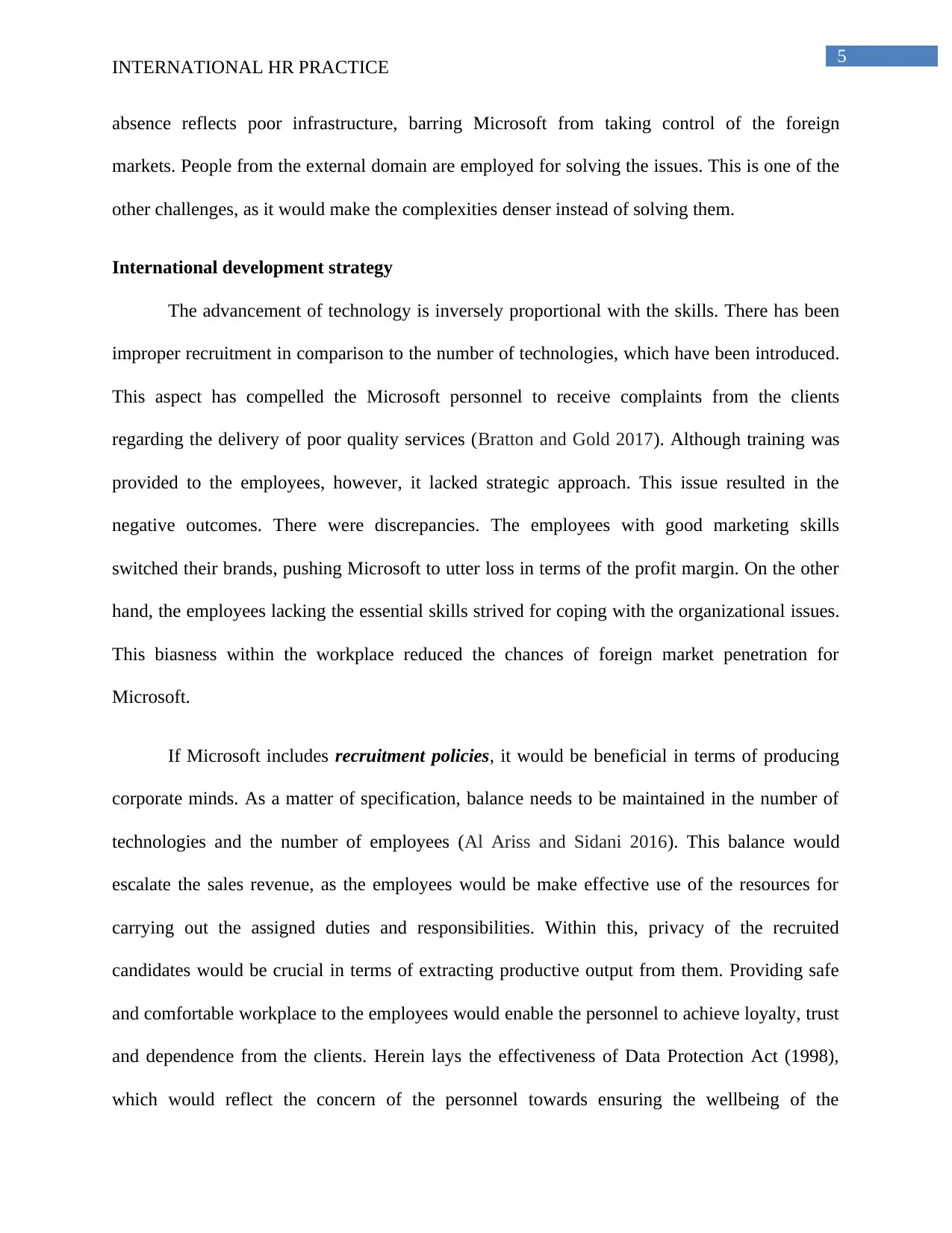
5
INTERNATIONAL HR PRACTICE
absence reflects poor infrastructure, barring Microsoft from taking control of the foreign
markets. People from the external domain are employed for solving the issues. This is one of the
other challenges, as it would make the complexities denser instead of solving them.
International development strategy
The advancement of technology is inversely proportional with the skills. There has been
improper recruitment in comparison to the number of technologies, which have been introduced.
This aspect has compelled the Microsoft personnel to receive complaints from the clients
regarding the delivery of poor quality services (Bratton and Gold 2017). Although training was
provided to the employees, however, it lacked strategic approach. This issue resulted in the
negative outcomes. There were discrepancies. The employees with good marketing skills
switched their brands, pushing Microsoft to utter loss in terms of the profit margin. On the other
hand, the employees lacking the essential skills strived for coping with the organizational issues.
This biasness within the workplace reduced the chances of foreign market penetration for
Microsoft.
If Microsoft includes recruitment policies, it would be beneficial in terms of producing
corporate minds. As a matter of specification, balance needs to be maintained in the number of
technologies and the number of employees (Al Ariss and Sidani 2016). This balance would
escalate the sales revenue, as the employees would be make effective use of the resources for
carrying out the assigned duties and responsibilities. Within this, privacy of the recruited
candidates would be crucial in terms of extracting productive output from them. Providing safe
and comfortable workplace to the employees would enable the personnel to achieve loyalty, trust
and dependence from the clients. Herein lays the effectiveness of Data Protection Act (1998),
which would reflect the concern of the personnel towards ensuring the wellbeing of the
INTERNATIONAL HR PRACTICE
absence reflects poor infrastructure, barring Microsoft from taking control of the foreign
markets. People from the external domain are employed for solving the issues. This is one of the
other challenges, as it would make the complexities denser instead of solving them.
International development strategy
The advancement of technology is inversely proportional with the skills. There has been
improper recruitment in comparison to the number of technologies, which have been introduced.
This aspect has compelled the Microsoft personnel to receive complaints from the clients
regarding the delivery of poor quality services (Bratton and Gold 2017). Although training was
provided to the employees, however, it lacked strategic approach. This issue resulted in the
negative outcomes. There were discrepancies. The employees with good marketing skills
switched their brands, pushing Microsoft to utter loss in terms of the profit margin. On the other
hand, the employees lacking the essential skills strived for coping with the organizational issues.
This biasness within the workplace reduced the chances of foreign market penetration for
Microsoft.
If Microsoft includes recruitment policies, it would be beneficial in terms of producing
corporate minds. As a matter of specification, balance needs to be maintained in the number of
technologies and the number of employees (Al Ariss and Sidani 2016). This balance would
escalate the sales revenue, as the employees would be make effective use of the resources for
carrying out the assigned duties and responsibilities. Within this, privacy of the recruited
candidates would be crucial in terms of extracting productive output from them. Providing safe
and comfortable workplace to the employees would enable the personnel to achieve loyalty, trust
and dependence from the clients. Herein lays the effectiveness of Data Protection Act (1998),
which would reflect the concern of the personnel towards ensuring the wellbeing of the

6
INTERNATIONAL HR PRACTICE
employees. Achieving productive output would fulfill the requirements of the clients. Rationality
in this direction might enable Microsoft to enhance their brand image till the extent of the foreign
markets (Marchington et al. 2016).
Task 2
Report on United Kingdom’s future expatriates
Hofstede’s cultural dimensions enhance the clarity of the readers regarding the different
cultures, which persists within the civilization. As a matter of specification, these dimensions
assess the behavioural approach of the people towards the events taking place in their
surroundings. This assessment is done through the factor analysis, taking into consideration
individualism-collectivism; uncertainty; avoidance; power distance; masculinity and femininity
(Tarique, Briscoe and Schuler 2015). The following is the assessment of the UK expatriates in
terms of the cultural dimensions.
1. High context versus low context cultures
UK culture is reflected in the communication. The expatriates on the foreign business
trips adhere to the national policies. This reflects the high score to the cultural values. Attempts
are made towards maintaining the stability in the relationship with the foreign clients. In their
personal life also, the expatriates ensuring that the individual sentiments of the associate partners
are not hurt. While providing jobs to the foreign candidates, they attempt to ensure that their
personal details are kept confidential (Hofstede-insights.com 2018). This reflects the use of Data
Protection Act (1998).
INTERNATIONAL HR PRACTICE
employees. Achieving productive output would fulfill the requirements of the clients. Rationality
in this direction might enable Microsoft to enhance their brand image till the extent of the foreign
markets (Marchington et al. 2016).
Task 2
Report on United Kingdom’s future expatriates
Hofstede’s cultural dimensions enhance the clarity of the readers regarding the different
cultures, which persists within the civilization. As a matter of specification, these dimensions
assess the behavioural approach of the people towards the events taking place in their
surroundings. This assessment is done through the factor analysis, taking into consideration
individualism-collectivism; uncertainty; avoidance; power distance; masculinity and femininity
(Tarique, Briscoe and Schuler 2015). The following is the assessment of the UK expatriates in
terms of the cultural dimensions.
1. High context versus low context cultures
UK culture is reflected in the communication. The expatriates on the foreign business
trips adhere to the national policies. This reflects the high score to the cultural values. Attempts
are made towards maintaining the stability in the relationship with the foreign clients. In their
personal life also, the expatriates ensuring that the individual sentiments of the associate partners
are not hurt. While providing jobs to the foreign candidates, they attempt to ensure that their
personal details are kept confidential (Hofstede-insights.com 2018). This reflects the use of Data
Protection Act (1998).
Paraphrase This Document
Need a fresh take? Get an instant paraphrase of this document with our AI Paraphraser
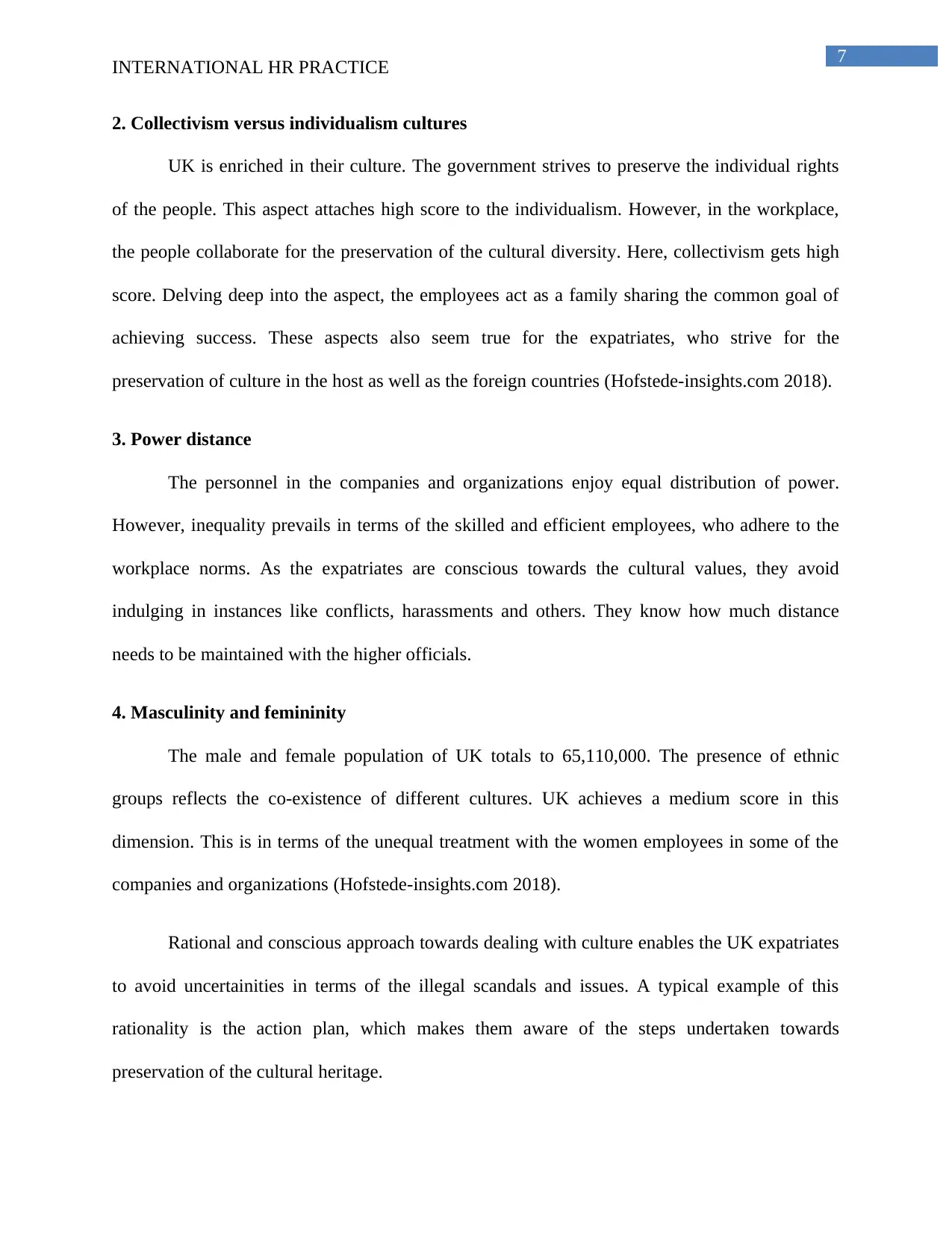
7
INTERNATIONAL HR PRACTICE
2. Collectivism versus individualism cultures
UK is enriched in their culture. The government strives to preserve the individual rights
of the people. This aspect attaches high score to the individualism. However, in the workplace,
the people collaborate for the preservation of the cultural diversity. Here, collectivism gets high
score. Delving deep into the aspect, the employees act as a family sharing the common goal of
achieving success. These aspects also seem true for the expatriates, who strive for the
preservation of culture in the host as well as the foreign countries (Hofstede-insights.com 2018).
3. Power distance
The personnel in the companies and organizations enjoy equal distribution of power.
However, inequality prevails in terms of the skilled and efficient employees, who adhere to the
workplace norms. As the expatriates are conscious towards the cultural values, they avoid
indulging in instances like conflicts, harassments and others. They know how much distance
needs to be maintained with the higher officials.
4. Masculinity and femininity
The male and female population of UK totals to 65,110,000. The presence of ethnic
groups reflects the co-existence of different cultures. UK achieves a medium score in this
dimension. This is in terms of the unequal treatment with the women employees in some of the
companies and organizations (Hofstede-insights.com 2018).
Rational and conscious approach towards dealing with culture enables the UK expatriates
to avoid uncertainities in terms of the illegal scandals and issues. A typical example of this
rationality is the action plan, which makes them aware of the steps undertaken towards
preservation of the cultural heritage.
INTERNATIONAL HR PRACTICE
2. Collectivism versus individualism cultures
UK is enriched in their culture. The government strives to preserve the individual rights
of the people. This aspect attaches high score to the individualism. However, in the workplace,
the people collaborate for the preservation of the cultural diversity. Here, collectivism gets high
score. Delving deep into the aspect, the employees act as a family sharing the common goal of
achieving success. These aspects also seem true for the expatriates, who strive for the
preservation of culture in the host as well as the foreign countries (Hofstede-insights.com 2018).
3. Power distance
The personnel in the companies and organizations enjoy equal distribution of power.
However, inequality prevails in terms of the skilled and efficient employees, who adhere to the
workplace norms. As the expatriates are conscious towards the cultural values, they avoid
indulging in instances like conflicts, harassments and others. They know how much distance
needs to be maintained with the higher officials.
4. Masculinity and femininity
The male and female population of UK totals to 65,110,000. The presence of ethnic
groups reflects the co-existence of different cultures. UK achieves a medium score in this
dimension. This is in terms of the unequal treatment with the women employees in some of the
companies and organizations (Hofstede-insights.com 2018).
Rational and conscious approach towards dealing with culture enables the UK expatriates
to avoid uncertainities in terms of the illegal scandals and issues. A typical example of this
rationality is the action plan, which makes them aware of the steps undertaken towards
preservation of the cultural heritage.
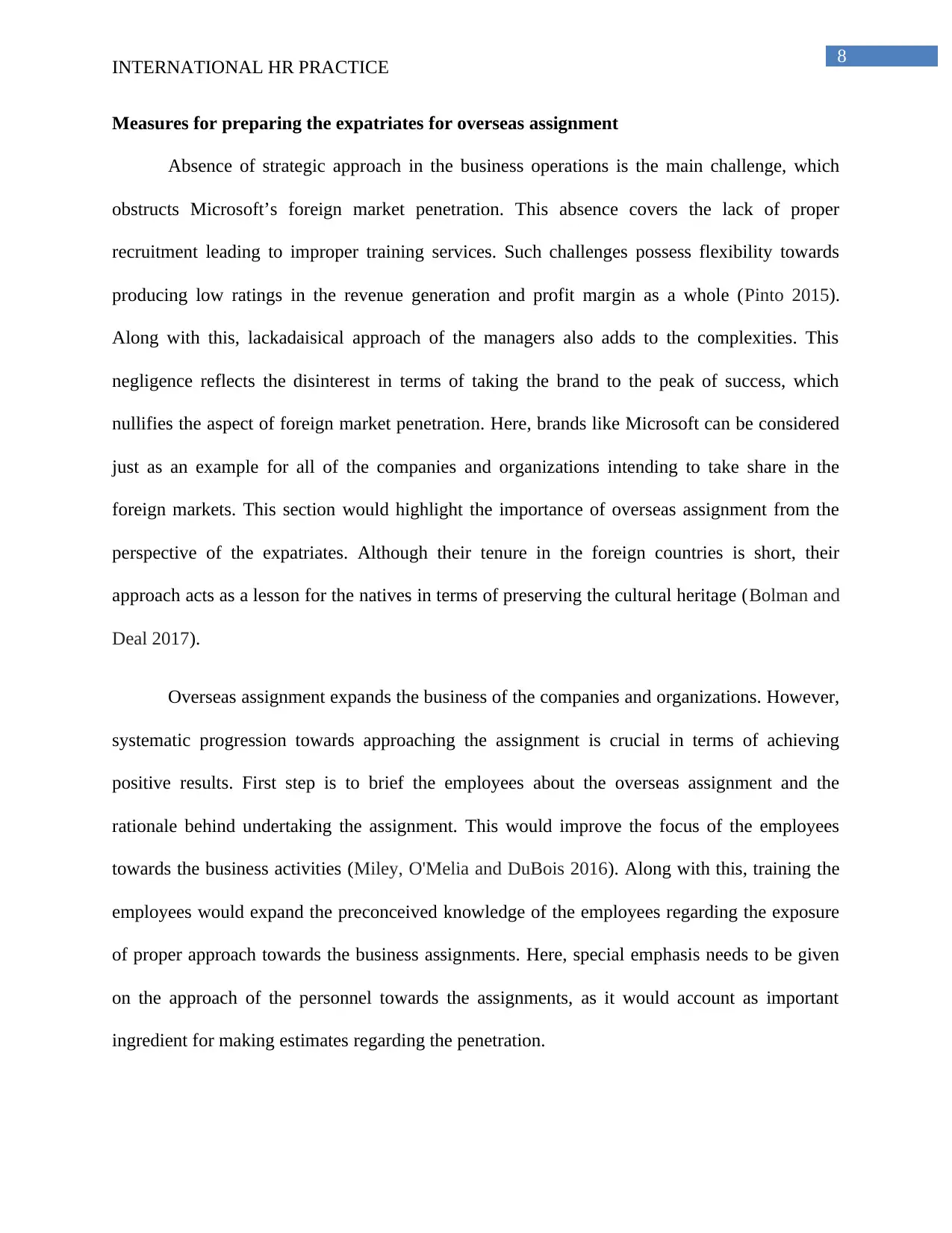
8
INTERNATIONAL HR PRACTICE
Measures for preparing the expatriates for overseas assignment
Absence of strategic approach in the business operations is the main challenge, which
obstructs Microsoft’s foreign market penetration. This absence covers the lack of proper
recruitment leading to improper training services. Such challenges possess flexibility towards
producing low ratings in the revenue generation and profit margin as a whole (Pinto 2015).
Along with this, lackadaisical approach of the managers also adds to the complexities. This
negligence reflects the disinterest in terms of taking the brand to the peak of success, which
nullifies the aspect of foreign market penetration. Here, brands like Microsoft can be considered
just as an example for all of the companies and organizations intending to take share in the
foreign markets. This section would highlight the importance of overseas assignment from the
perspective of the expatriates. Although their tenure in the foreign countries is short, their
approach acts as a lesson for the natives in terms of preserving the cultural heritage (Bolman and
Deal 2017).
Overseas assignment expands the business of the companies and organizations. However,
systematic progression towards approaching the assignment is crucial in terms of achieving
positive results. First step is to brief the employees about the overseas assignment and the
rationale behind undertaking the assignment. This would improve the focus of the employees
towards the business activities (Miley, O'Melia and DuBois 2016). Along with this, training the
employees would expand the preconceived knowledge of the employees regarding the exposure
of proper approach towards the business assignments. Here, special emphasis needs to be given
on the approach of the personnel towards the assignments, as it would account as important
ingredient for making estimates regarding the penetration.
INTERNATIONAL HR PRACTICE
Measures for preparing the expatriates for overseas assignment
Absence of strategic approach in the business operations is the main challenge, which
obstructs Microsoft’s foreign market penetration. This absence covers the lack of proper
recruitment leading to improper training services. Such challenges possess flexibility towards
producing low ratings in the revenue generation and profit margin as a whole (Pinto 2015).
Along with this, lackadaisical approach of the managers also adds to the complexities. This
negligence reflects the disinterest in terms of taking the brand to the peak of success, which
nullifies the aspect of foreign market penetration. Here, brands like Microsoft can be considered
just as an example for all of the companies and organizations intending to take share in the
foreign markets. This section would highlight the importance of overseas assignment from the
perspective of the expatriates. Although their tenure in the foreign countries is short, their
approach acts as a lesson for the natives in terms of preserving the cultural heritage (Bolman and
Deal 2017).
Overseas assignment expands the business of the companies and organizations. However,
systematic progression towards approaching the assignment is crucial in terms of achieving
positive results. First step is to brief the employees about the overseas assignment and the
rationale behind undertaking the assignment. This would improve the focus of the employees
towards the business activities (Miley, O'Melia and DuBois 2016). Along with this, training the
employees would expand the preconceived knowledge of the employees regarding the exposure
of proper approach towards the business assignments. Here, special emphasis needs to be given
on the approach of the personnel towards the assignments, as it would account as important
ingredient for making estimates regarding the penetration.
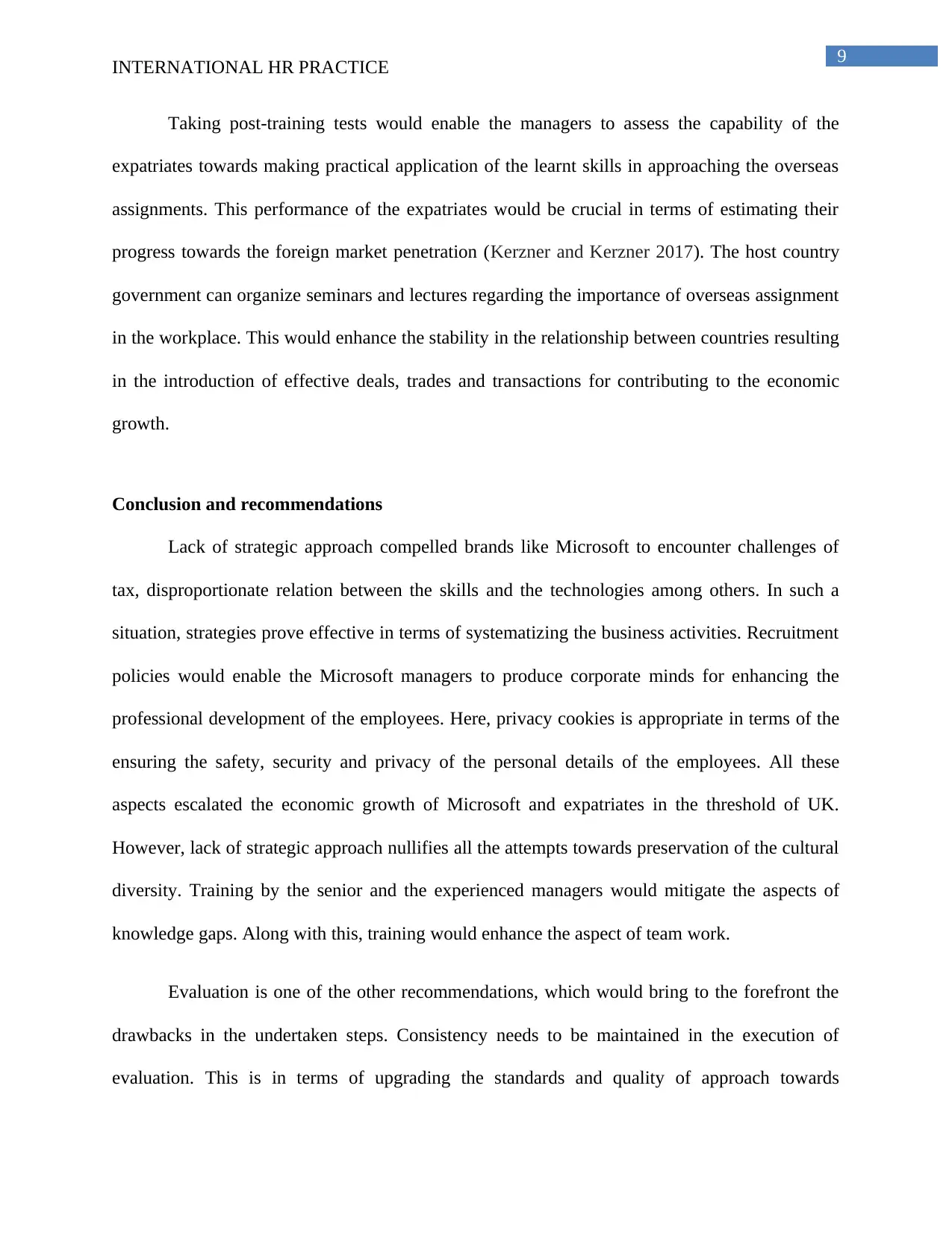
9
INTERNATIONAL HR PRACTICE
Taking post-training tests would enable the managers to assess the capability of the
expatriates towards making practical application of the learnt skills in approaching the overseas
assignments. This performance of the expatriates would be crucial in terms of estimating their
progress towards the foreign market penetration (Kerzner and Kerzner 2017). The host country
government can organize seminars and lectures regarding the importance of overseas assignment
in the workplace. This would enhance the stability in the relationship between countries resulting
in the introduction of effective deals, trades and transactions for contributing to the economic
growth.
Conclusion and recommendations
Lack of strategic approach compelled brands like Microsoft to encounter challenges of
tax, disproportionate relation between the skills and the technologies among others. In such a
situation, strategies prove effective in terms of systematizing the business activities. Recruitment
policies would enable the Microsoft managers to produce corporate minds for enhancing the
professional development of the employees. Here, privacy cookies is appropriate in terms of the
ensuring the safety, security and privacy of the personal details of the employees. All these
aspects escalated the economic growth of Microsoft and expatriates in the threshold of UK.
However, lack of strategic approach nullifies all the attempts towards preservation of the cultural
diversity. Training by the senior and the experienced managers would mitigate the aspects of
knowledge gaps. Along with this, training would enhance the aspect of team work.
Evaluation is one of the other recommendations, which would bring to the forefront the
drawbacks in the undertaken steps. Consistency needs to be maintained in the execution of
evaluation. This is in terms of upgrading the standards and quality of approach towards
INTERNATIONAL HR PRACTICE
Taking post-training tests would enable the managers to assess the capability of the
expatriates towards making practical application of the learnt skills in approaching the overseas
assignments. This performance of the expatriates would be crucial in terms of estimating their
progress towards the foreign market penetration (Kerzner and Kerzner 2017). The host country
government can organize seminars and lectures regarding the importance of overseas assignment
in the workplace. This would enhance the stability in the relationship between countries resulting
in the introduction of effective deals, trades and transactions for contributing to the economic
growth.
Conclusion and recommendations
Lack of strategic approach compelled brands like Microsoft to encounter challenges of
tax, disproportionate relation between the skills and the technologies among others. In such a
situation, strategies prove effective in terms of systematizing the business activities. Recruitment
policies would enable the Microsoft managers to produce corporate minds for enhancing the
professional development of the employees. Here, privacy cookies is appropriate in terms of the
ensuring the safety, security and privacy of the personal details of the employees. All these
aspects escalated the economic growth of Microsoft and expatriates in the threshold of UK.
However, lack of strategic approach nullifies all the attempts towards preservation of the cultural
diversity. Training by the senior and the experienced managers would mitigate the aspects of
knowledge gaps. Along with this, training would enhance the aspect of team work.
Evaluation is one of the other recommendations, which would bring to the forefront the
drawbacks in the undertaken steps. Consistency needs to be maintained in the execution of
evaluation. This is in terms of upgrading the standards and quality of approach towards
Secure Best Marks with AI Grader
Need help grading? Try our AI Grader for instant feedback on your assignments.
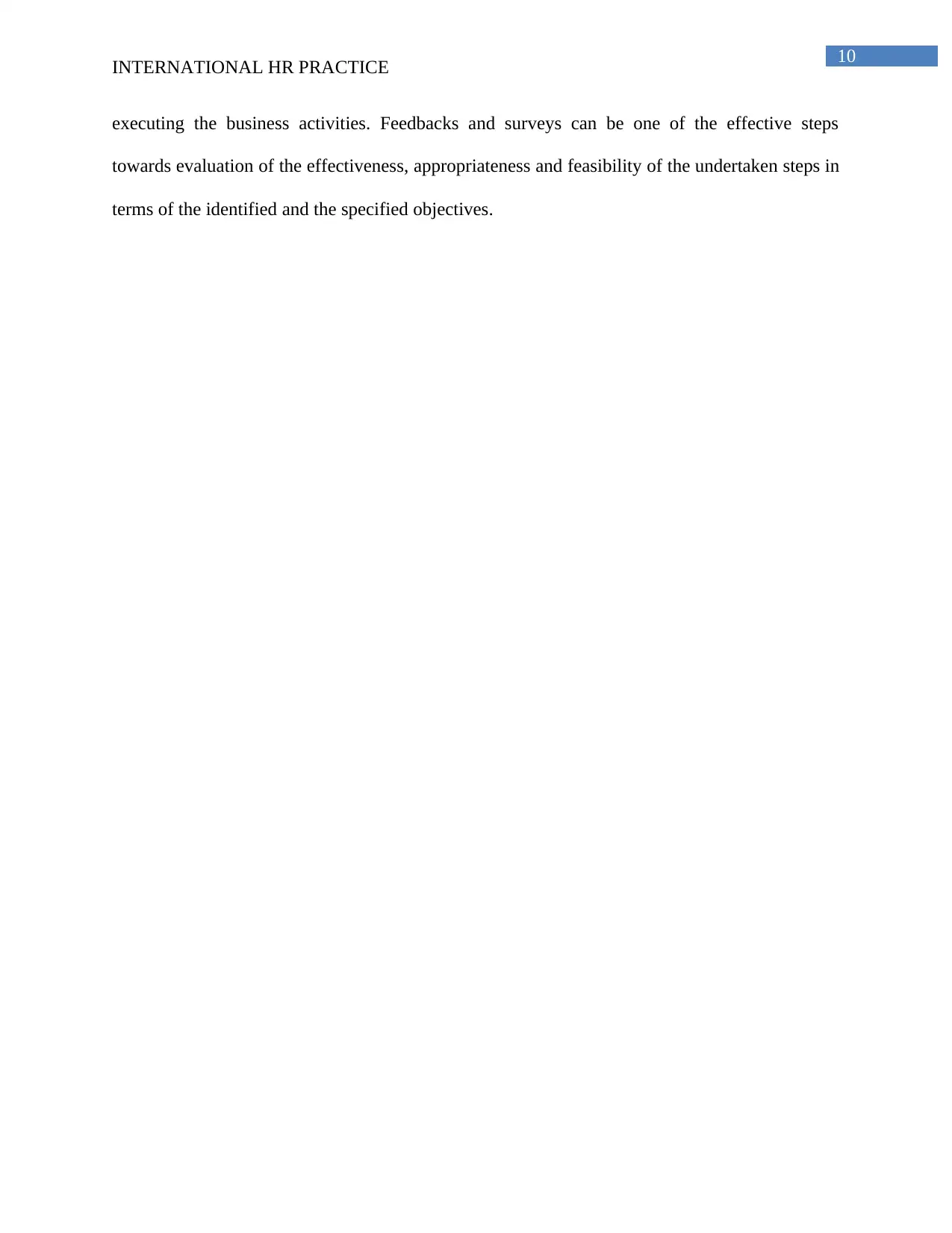
10
INTERNATIONAL HR PRACTICE
executing the business activities. Feedbacks and surveys can be one of the effective steps
towards evaluation of the effectiveness, appropriateness and feasibility of the undertaken steps in
terms of the identified and the specified objectives.
INTERNATIONAL HR PRACTICE
executing the business activities. Feedbacks and surveys can be one of the effective steps
towards evaluation of the effectiveness, appropriateness and feasibility of the undertaken steps in
terms of the identified and the specified objectives.
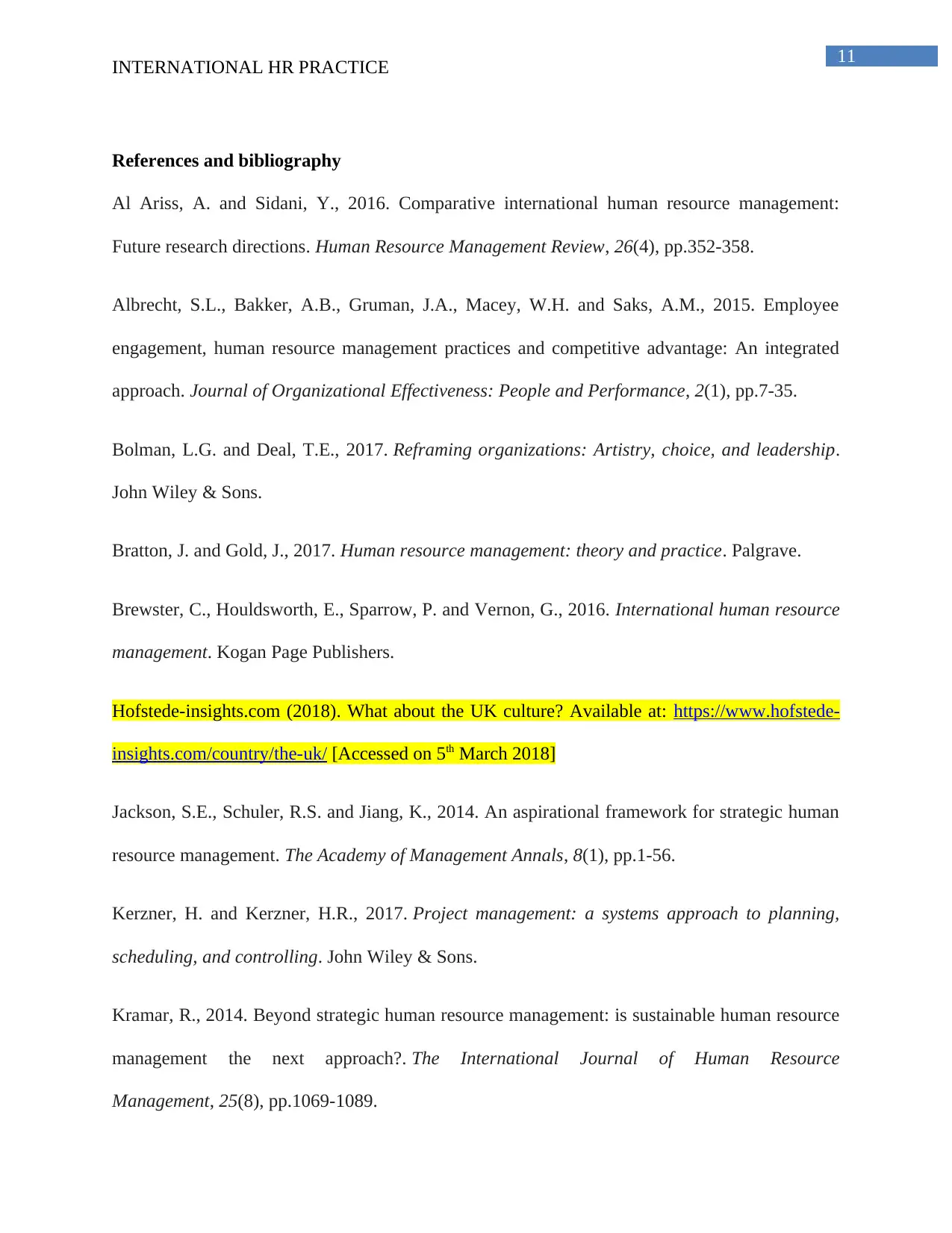
11
INTERNATIONAL HR PRACTICE
References and bibliography
Al Ariss, A. and Sidani, Y., 2016. Comparative international human resource management:
Future research directions. Human Resource Management Review, 26(4), pp.352-358.
Albrecht, S.L., Bakker, A.B., Gruman, J.A., Macey, W.H. and Saks, A.M., 2015. Employee
engagement, human resource management practices and competitive advantage: An integrated
approach. Journal of Organizational Effectiveness: People and Performance, 2(1), pp.7-35.
Bolman, L.G. and Deal, T.E., 2017. Reframing organizations: Artistry, choice, and leadership.
John Wiley & Sons.
Bratton, J. and Gold, J., 2017. Human resource management: theory and practice. Palgrave.
Brewster, C., Houldsworth, E., Sparrow, P. and Vernon, G., 2016. International human resource
management. Kogan Page Publishers.
Hofstede-insights.com (2018). What about the UK culture? Available at: https://www.hofstede-
insights.com/country/the-uk/ [Accessed on 5th March 2018]
Jackson, S.E., Schuler, R.S. and Jiang, K., 2014. An aspirational framework for strategic human
resource management. The Academy of Management Annals, 8(1), pp.1-56.
Kerzner, H. and Kerzner, H.R., 2017. Project management: a systems approach to planning,
scheduling, and controlling. John Wiley & Sons.
Kramar, R., 2014. Beyond strategic human resource management: is sustainable human resource
management the next approach?. The International Journal of Human Resource
Management, 25(8), pp.1069-1089.
INTERNATIONAL HR PRACTICE
References and bibliography
Al Ariss, A. and Sidani, Y., 2016. Comparative international human resource management:
Future research directions. Human Resource Management Review, 26(4), pp.352-358.
Albrecht, S.L., Bakker, A.B., Gruman, J.A., Macey, W.H. and Saks, A.M., 2015. Employee
engagement, human resource management practices and competitive advantage: An integrated
approach. Journal of Organizational Effectiveness: People and Performance, 2(1), pp.7-35.
Bolman, L.G. and Deal, T.E., 2017. Reframing organizations: Artistry, choice, and leadership.
John Wiley & Sons.
Bratton, J. and Gold, J., 2017. Human resource management: theory and practice. Palgrave.
Brewster, C., Houldsworth, E., Sparrow, P. and Vernon, G., 2016. International human resource
management. Kogan Page Publishers.
Hofstede-insights.com (2018). What about the UK culture? Available at: https://www.hofstede-
insights.com/country/the-uk/ [Accessed on 5th March 2018]
Jackson, S.E., Schuler, R.S. and Jiang, K., 2014. An aspirational framework for strategic human
resource management. The Academy of Management Annals, 8(1), pp.1-56.
Kerzner, H. and Kerzner, H.R., 2017. Project management: a systems approach to planning,
scheduling, and controlling. John Wiley & Sons.
Kramar, R., 2014. Beyond strategic human resource management: is sustainable human resource
management the next approach?. The International Journal of Human Resource
Management, 25(8), pp.1069-1089.
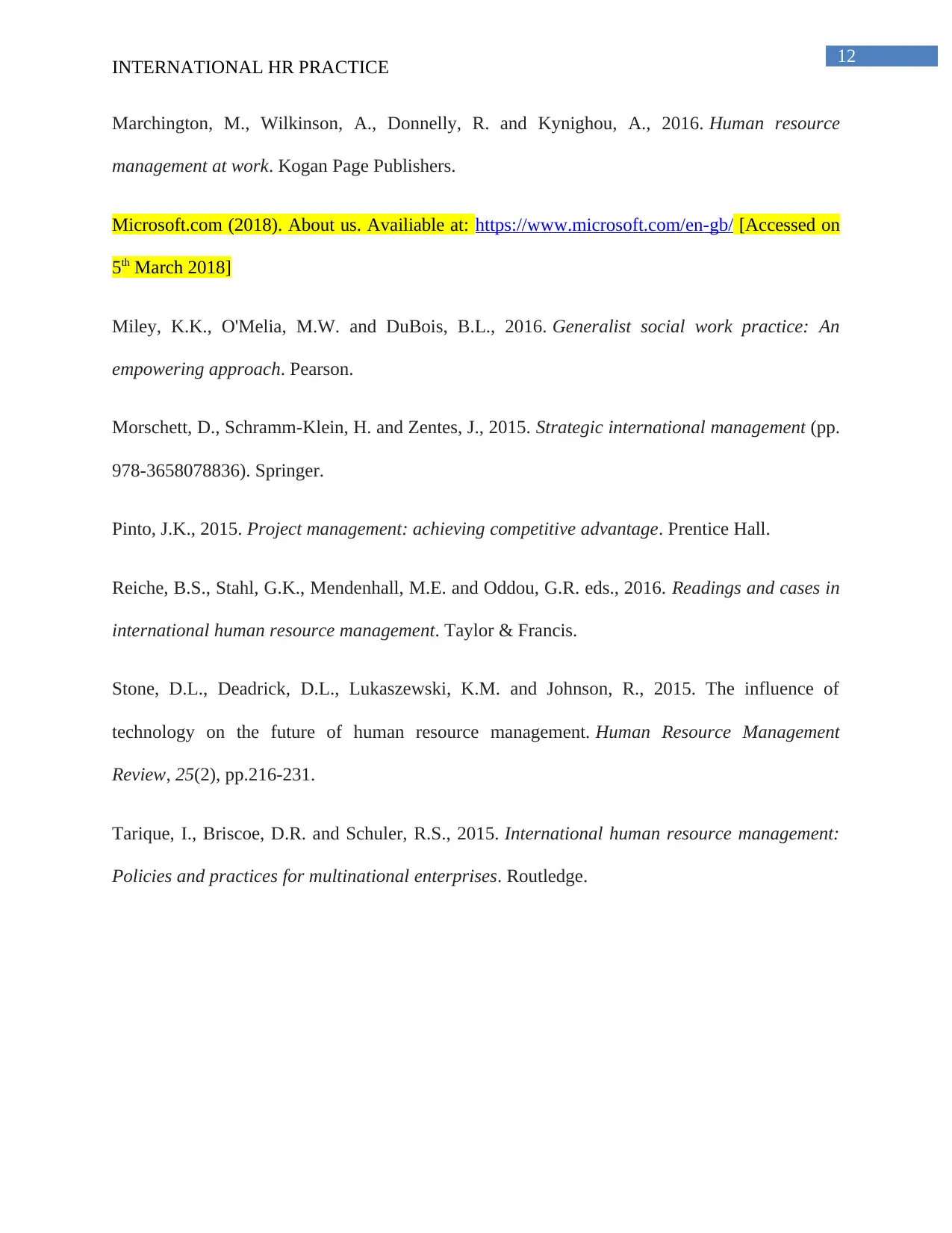
12
INTERNATIONAL HR PRACTICE
Marchington, M., Wilkinson, A., Donnelly, R. and Kynighou, A., 2016. Human resource
management at work. Kogan Page Publishers.
Microsoft.com (2018). About us. Availiable at: https://www.microsoft.com/en-gb/ [Accessed on
5th March 2018]
Miley, K.K., O'Melia, M.W. and DuBois, B.L., 2016. Generalist social work practice: An
empowering approach. Pearson.
Morschett, D., Schramm-Klein, H. and Zentes, J., 2015. Strategic international management (pp.
978-3658078836). Springer.
Pinto, J.K., 2015. Project management: achieving competitive advantage. Prentice Hall.
Reiche, B.S., Stahl, G.K., Mendenhall, M.E. and Oddou, G.R. eds., 2016. Readings and cases in
international human resource management. Taylor & Francis.
Stone, D.L., Deadrick, D.L., Lukaszewski, K.M. and Johnson, R., 2015. The influence of
technology on the future of human resource management. Human Resource Management
Review, 25(2), pp.216-231.
Tarique, I., Briscoe, D.R. and Schuler, R.S., 2015. International human resource management:
Policies and practices for multinational enterprises. Routledge.
INTERNATIONAL HR PRACTICE
Marchington, M., Wilkinson, A., Donnelly, R. and Kynighou, A., 2016. Human resource
management at work. Kogan Page Publishers.
Microsoft.com (2018). About us. Availiable at: https://www.microsoft.com/en-gb/ [Accessed on
5th March 2018]
Miley, K.K., O'Melia, M.W. and DuBois, B.L., 2016. Generalist social work practice: An
empowering approach. Pearson.
Morschett, D., Schramm-Klein, H. and Zentes, J., 2015. Strategic international management (pp.
978-3658078836). Springer.
Pinto, J.K., 2015. Project management: achieving competitive advantage. Prentice Hall.
Reiche, B.S., Stahl, G.K., Mendenhall, M.E. and Oddou, G.R. eds., 2016. Readings and cases in
international human resource management. Taylor & Francis.
Stone, D.L., Deadrick, D.L., Lukaszewski, K.M. and Johnson, R., 2015. The influence of
technology on the future of human resource management. Human Resource Management
Review, 25(2), pp.216-231.
Tarique, I., Briscoe, D.R. and Schuler, R.S., 2015. International human resource management:
Policies and practices for multinational enterprises. Routledge.
1 out of 13
Related Documents
Your All-in-One AI-Powered Toolkit for Academic Success.
+13062052269
info@desklib.com
Available 24*7 on WhatsApp / Email
![[object Object]](/_next/static/media/star-bottom.7253800d.svg)
Unlock your academic potential
© 2024 | Zucol Services PVT LTD | All rights reserved.





